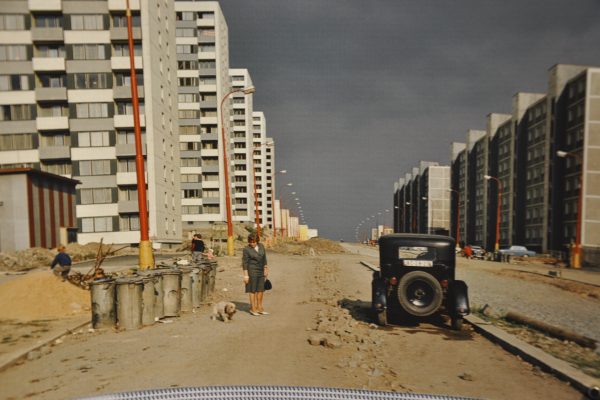I have to recognise it’s cosmical; the shit is cosmical. It’s not just social, it’s not just ontological, it’s really huge. And that’s why we expand. (Béla Tarr, 2007)
Béla Tarr is a director who divides the field. He makes slow, stark films about lives in which little happens, combining old-fashioned values and innovative methods. He records the basic elements of domestic life with incongruously sweeping, virtuoso cinematography and picks apart the rudiments of human role-play with elaborate subtlety, coordinating gritty detail and a sense of the universal in a way that some see as visionary and others find tedious. Jonathan Rosenbaum, the American film critic, has dubbed Tarr a ‘despiritualised Tarkovsky’. I find him a less lapsed and more conflicted creature: a hopeful cynic or scatological mystic, whose films are as aggressively earthbound as they are inspiring.
Born and raised in Hungary, Béla Tarr began his directing career in the 1970s at the Béla Balázs studios in Budapest, where he fell in with a group of ‘documentarist’ directors dedicated to representing the lives of the working class in as pared-down and unembellished a way as possible. his early films Family Nest (1979) and The Outsider (1981) are classic examples of the school, but through the eighties he developed away from it as he absorbed the influences of European art house cinema, particularly Rainer Werner Fassbinder and Jean-Luc Godard, and became interested in form, composition, metaphysics and the history of film.
In 1984 he began collaborating with the Hungarian writer László Krasznahorkai, with whom he went on to create many of his greatest films, Damnation (1988), Sátántangó (1994) and Werckmeister Harmonies (2000) – these last two adaptations of Krasznahorkai’s novels Sátántangó and The Melancholy of Resistance, respectively. The elaborate sentences and unorthodox structures of Krasznahorkai’s novels seem to have informed Tarr’s own formal innovations – the lengthy takes, chapter divisions and sprawling psychological odysseys of which his later films are composed. It is also in Krasznahorkai’s literature that Tarr seems to have identified a vast and surreal perspective through which to envision the lives of ordinary people. Though the range of Tarr’s artistic relationships and interests has shaped a highly distinctive approach, it also has much to do with his cultural position. Working between Soviet-scarred Hungary and the comparatively prosperous and liberated West seems to have afforded him a peculiarly mixed sensibility: aesthetically both spartan and grand and politically as aspirational as it is hopeless.
Tarr has only made nine feature films and claims that his most recent, The Turin Horse (2011), will be his last. Though dogged by a cult following from his early output, it is only in the past decade that he has acquired a fuller fan-base, starting with Artificial Eye’s release of his films on DVD and culminating in the Jury Grand Prix award for The Turin Horse, co-written with Krasznahorkai, at the Berlin Film Festival in 2011. yet he is still little known and much misunderstood. If his latest film is indeed to be his last, he surely deserves an appraisal that debunks the myths surrounding his work and celebrates what he has discreetly created. The shit is cosmical: he has made for cinema a prosaic sublime.
His is an art form of dissolving contrasts in which the everyday lives of individuals are located within the broader frameworks of politics and nature. Minutiae are shown to contain the seeds of power, survival or despair, and the vile or banal is filmed with astonishing sensitivity. This is an essentially disproportionate worldview that pits paradox against conventional logic, taste or taxonomy. It follows the effects of huge historical, even meteorological forces on tiny populations; it proves that beauty can inhere in something as simple as wood grain; and it suggests different ways in which to conceive of, even perhaps accept, cruelty and boredom. Alternatively it witnesses how such sliding scales and acute contrasts might provoke madness or revelation. In The Turin Horse there is a long, luminous chiaroscuro close-up of a steaming baked potato. In isolation it might seem bland, indulgent or absurd, but in the story’s context of desperate hunger, the messianic splendour of the vegetable makes sense. In this way the excesses or eccentricities of Tarr’s vision have a function in depicting lives distorted by hardship or isolation. This gloss of the prosaic sublime sheds light on the director by elucidating the ways in which apparently contradictory, inappropriate, fanciful or gratuitously depressing elements in his work also have radical meaning.
***
Typically, Béla Tarr’s films follow the decline of small, poor, rural communities in Eastern Europe, as in Damnation, Werckmeister Harmonies and Sátántangó. These are often construed as dystopian fables on the fall of Communism and understood in terms of Tarr’s Hungarian nationality. His films are artefacts of his country’s post-communist existence and the need to communicate this is a major motive for his film-making. He has said of Werckmeister Harmonies, ‘I have a hope, if you watch this film, you understand something about our life, about what is happening in middle Europe, how we are living there, in a kind of edge of the world.’ Yet his scripts and direction suggest at an immediate level a less politically pointed and more general agenda. There are no named locations or historical references in his work. When he talks about ‘the shit’ he has clarified that he means the human condition, not the Hungarian situation. Shot in villages and taking the form of a folk tale or twisted morality play in the manner of Lars von Trier’s Dogville, his films are the stories of any sublunar striving. Prosaic in subject, style and appeal, they are about common experience.
Most of Béla Tarr’s characters are mired in shit of some kind or other. his films are usually set in unforgiving landscapes and grim weather. There is barely a dry shot in Damnation, with its backdrop of epic rain and its foreground of mud. The Turin Horse unfolds on a bare steppe whipped by spectacularly strong winds. And his magnum opus Sátántangó is a whorling world of grey skies and sodden earth through which the locals hopelessly grope.
These surroundings are atmospheric but to mention pathetic fallacy here would imply a distinction entirely absent from Tarr’s artistic vision. In the literary device, a character’s surroundings reflect their thoughts or feelings; in Tarr’s films there is no such divide and no such mirroring. For him, the material make-up of life constitutes a soul as much as anything else and to understand Tarr’s outlook is not to analyse but to enter into the physical experiences of his actors. This isn’t difficult, for his films are powerfully visceral, the weather and sets as deeply textured and evocative as any words or personalities. I emerged from The Turin Horse feeling as storm-battered as moved. The effects are necessarily related: the harsh conditions in which the two protagonists live underwrite the brute simplicity of their relationship. In all of Tarr’s films there is a strong synthesis between the basic elements of a place and the psychology of its people. The landscape and characters are wholly unified, transcending metaphorical distinctions. In Sátántangó the muck underfoot and the filthy politics of village life are of a piece; enduring the bodily toils of a rustic existence and resisting the parochial backslide into vice are part of the same struggle.
It is in this context that his characters acquire a certain stature: not so much a matter of surviving in spite of circumstances as of living through them. Regarding the sublime, his work certainly contains enough horror to court the darker sense of the word: the provocation of awe and fear that Enlightenment philosophers inscribed in the term. But Tarr inverts the inherited understanding, locating irrational terror in the deeply primitive rather than in the spiritual. Sátántangó, as its title might suggest, is a carnivalesque of the lower depths. A brother robs his little sister of her pittance pocket money. She in turn tortures a cat to death, then poisons herself – and meanwhile the villagers scheme, drink, dance and fuck themselves senseless over twelve chapters that gyre and descend like so many spirals of hell. Werckmeister Harmonies reaches a more acute climax, in which the locals vandalise a hospital and abuse its patients, in one of the least explicit but most disturbing scenes in the history of cinematic violence.
Yet for all their raw brutality, Béla Tarr’s films are also surprisingly full of wonder: from the mystery of the ringing bells in Sátántangó to the glorious enigma of the whale in Werckmeister Harmonies. Otherwise relentlessly harsh narratives are interrupted by marvels, all the more marvellous for their unlikely settings. Though these incidents tend to come from nature or folk mythology, they bring into play forces beyond human comprehension, adding an extraordinary and uplifting dimension to Tarr’s world.
There is also a much nearer form of the sublime in his work in the ideal of dignity, which stands as a godless equivalent to salvation and an alternative to the easier secular lodestars of romance, success or celebrity. These forms of redemption all tend to arrive via some deus ex machina, but Tarr would prefer his characters to acquire their own grace. As he told Howard Feinstein, ‘All our movies is [sic] talking about the human dignity and I think this is the point of view which is the main issue.’ he complains that the word has fallen into disuse and it is as if his films attempt to rescue the concept from dour worthiness or sanctimony and rearticulate not only the importance but the beauty – glamour, even – of dignity. The singer in Damnation is a heroine in this vein, a woman eking out a melancholy existence in a backwater town with a miraculous degree of style. she has liquidly greasy hair; she moans and groans at the local dive for a living; we even watch her give her boss a blowjob under the bar. And yet, against all odds, she maintains a livelihood, as well as her sex appeal, charisma and integrity. As she tells her would-be lover, Kamer, ‘I know that I’m alone, I know it well, but I’ll not give up,’ – which pillow talk amounts to the moral of this particular story, or the closest we ever get to one. More flexible and modulated than stoicism: an individual’s means of coping within society with their own rough forms of physical and ethical elegance.
In Artforum James Quandt wrote that Béla Tarr’s films are often about escapes, made or missed. This offers a potential key to his world, but only as a kind of inverse truth. Tarr handles any kind of ‘beyond’ with a blunt scepticism; where escape is mooted, it is more a myth or a parody of reality than a possibility. In Damnation and Sátántangó, characters long and attempt to flee their miserable homes, but are prevented, more often by a lack of alternatives than by a lack of courage. flight becomes increasingly irrelevant as a solution to the states of social or psychological despair that characters suffer. Sorrow is ubiquitous; shifting ground a red herring and, moreover, a cop-out, both as a plot-device and life-decision. Escape is never an option, but it does throw those available into relief. surviving with as much humanity as you can muster is often the best, or only, course. Happily, this doubles as a practical solution for his characters and a value system for Tarr, synthesising both his neorealist and his ideological ambitions by conferring a naturalistic heroism on characters who do what they have to.
So far so serious, but Tarr is also the master of a dry, dark type of comedy and underlying any hope in his films is a cynicism that fuels their black humour. There are no dead baby gags but the gung-ho bawdiness with which the cast of Sátántangó inevitably decline does curl the corners of the mouth – if curving closer to a grimace. There is also a kind of slow, sadomasochistic joke in the absurd length of the tragedies Tarr drags himself and his viewers through. Both Damnation and Sátántangó feature strung-out bar scenes in which the revellers all eventually depart or pass out, leaving a last man standing in the early hours to the mock-glorious strains of an accordion. The music mimics a wink at the audience, sending up and garlanding the drunkard’s perseverance, while simultaneously burlesquing the viewer’s stamina. Like the punters, you can always leave, but you probably won’t.
***
Tarr is famous, or infamous, for staggeringly long takes. Sátántangó runs at over 7 hours and is made of only 150 takes. he would have them longer if he could, complaining that his only limit is the length of Kodak film, which stretches to 300m, about 11 minutes. This is extremely unusual by today’s standards – the average take now lasts but a few seconds – making his films challenging to watch and urging some justification for their length. To an extent, the dilatory nature of his films is a way of celebrating (and demanding) endurance. More importantly though, it effects a kind of durational empathy. Watching Damnation or Sátántangó creates a strong impression of what life must be like in such hamlets – like watching paint not dry.
There is a crucial difference, though, between an art form that conveys ennui and suffering and an art form that is just painfully boring. Tarr’s prodigious talent as a visual director is perhaps the necessary complement to the time he takes as the awesome beauty of the cinematography in his films renders them (almost) endlessly watchable. And while I don’t agree with Susan Sontag that Sátántangó is ‘enthralling for every minute of its seven hours’, I do think it is exquisite to look at for its entire duration.There are the spectral portraits of Esti, slow pale shots, almost quivering stills, that communicate the bleached out blankness of her existence more powerfully than any words might; or those sequences where the camera stalks characters walking to and from the village, through landscapes so magnificently bleak you perversely yearn to be there; and then, of course, the orgiastic pub scene at the heart of the film, a figurative grotesque as repulsively seductive as anything Hieronymus Bosch or David Lynch might dream up.
Tarr is certainly not the puritan some of his directorial dogma might suggest. Far from the asceticism of his early documentarist approach, his later cinematography is always aesthetically appealing and his narratives full of comedy, cynicism, brawling, lust and artistic reference. In his mature work he appropriates painters (Bruegel, Caravaggio, Vermeer, van Gogh) and cinematic tropes like the overt noirishness of Damnation and The Man From London. Music also becomes increasingly important; Werckmeister Harmonies’ title refers to a baroque music theorist and the need to recalibrate harmony. Mihály Víg’s musical scores play no small part in the film, providing simple but soaring accompaniments that stay in keeping with the tone, as do his expansive compositions for Sátántangó and The Turin Horse.
This is all quite awkward. On one hand, Tarr appears to insist on rugged honesty and on the other he makes films that are operatic in their artistic complexity and ambition. He snubs the loftiness of Art with a capital A but claims all mainstream cinema is ‘shit’ (and presumably not cosmical). Yet, though Tarr does evade categorisation, this would appear to be less an obtuse pose for the critics and more a straightforward reflection of his attitude and peculiarity as a director. His films are unique. They don’t cleave to the redemptive structures of Hollywood romance and have little of the speed, wit, décor or lifestyle references that distance many indie films from reality and imbue them with a richness absent from it. Bresson, Godard or Rainer Werner Fassbinder may not rose-tint their worlds, but they do culturally console both their characters and their viewers. you might feel sad or outcast in any of their films, but at least you have the comfort of being unquestionably cool with it. They offer the lonely some sense of belonging to a set of aesthetics.
Tarr’s films seem to work the other way; they are about the qualities of individuals within groups rather than what he would see as the false yoke of plot or vogue. A cited influence here is Bruegel. In a Kinoeye interview Tarr discusses his admiration for the painter’s talent for drawing out the peculiar nature of each figure in a crowd, saying, ‘Everyone has a personality. That’s the reason I like Bruegel and that’s what I learned from him.’
There is a scene at the end of Werckmeister Harmonies which feels like an homage to the old master: a local community is filmed standing outside the village hall. The framing and composition recall scenes typical of the painter. An overall effect of unity is conveyed in long-distance shots of panoramic width that survey the ragged group in its entirety, before a long close-up sequence that examines the individuals and their relations to one another in detail, the camera moving slowly from one face to the next, every one an index of responses to the collective drama they have each taken part in and witnessed. The scene is strangely affecting, yet all it does is affirm the place of these rather compromised individuals within their world. Nothing has been distorted, explained, resolved or promised, but something has been quietly fêted.
Bruegel magnified the rudimentary and in this respect is an obvious precursor to Tarr. And yet, the director would rail against any such status, claiming, ‘for me, the biggest danger is somebody telling me you are an artist.’ Though the prosaic elements in his work make some sense of his paranoia, I suspect a degree of stubbornness, even mendacity, in his anti-art posturing. It is impossible to watch his films without observing how strikingly beautiful they are and this is no coincidence – most of them take years to make and the production is painstaking. It isn’t unmotivated – beauty clearly has a function for him. Tarr might not want to spin illusions or sanctify any squalor, and he certainly isn’t courting the cinematic canon, but he does want to dignify his subjects and appears to do so through a profoundly poetic visual language. Denying himself or his work an artistic status seems extremely unconvincing and unnecessary. Why might he maintain such a position?
At a strategic level, it looks defensive. His work eludes the zeitgeist, being too down to earth for fashion; too simple for intellectualism; and too earnest for irony. Wooing the contemporary art scene would probably prove a vain pursuit. More fundamentally, though, he appears chary of the critical discourse that is now the lifeblood of contemporary culture (if also vampiric), and there is an extent to which he might downplay the credentials and media coverage of his films to preserve their autonomy, the primacy of what he calls a ‘primitive language’. The prevailing truth of the matter, though, is that he doesn’t give a shit what anyone thinks. Which isn’t indifference; it’s a gesture of faith in his work.
The real shame of this silence is that it generates misconceptions. Worst among them, Susan Sontag’s recruitment of his films as ‘heroic violations of the norm’ in her moribund-lament-cum-lofty-rant about the decay of film standards and the dying super-species of cinéastes. Though Tarr is anti-establishment, Sontag’s is precisely the sort of counter-conversation he doesn’t want to enter, her ‘Death of Cinephilia’ another wave of crusading hysteria turning him agnostic. Cinema is not dead, and he would rather prove it by making films than talking about them or joining a cause. And if The Turin Horse is to be his final film, I suspect it is also the last we will hear from him, marking an apparent immunity to the reception of his work that is, again, quite unusual.
Working outside of any local, mainstream, art house or realist collective makes him something of an anomaly. By choosing not to take part in today’s creative dialogues and eschewing the cultural milieu within which his films have to exist (they need to be screened to be seen), he runs the risk of making films that are less immediately relevant to their audiences, but in the hope that they ultimately have a broader reach. A new set of ideals emerges through this cinema, a prosaic sublime. unmodish and of epic scope, it is Everyman’s art.




